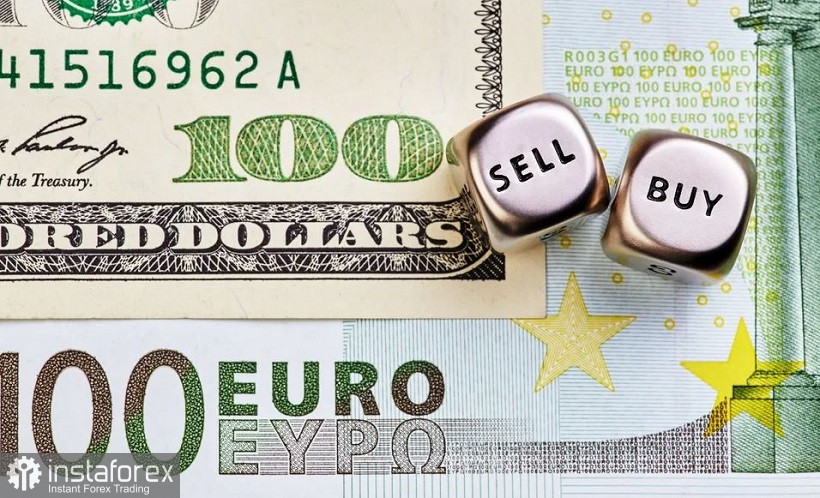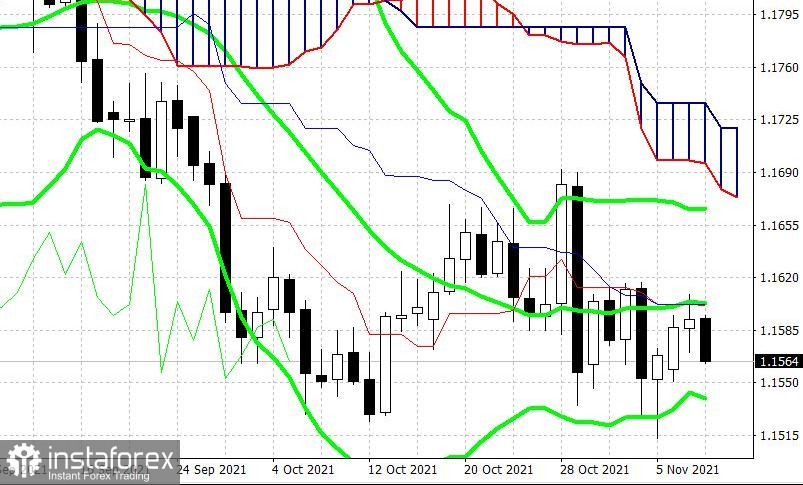The EUR/USD pair continues to trade in the price range of 1.1530-1.1600, in anticipation of the growth of US inflation – the key macroeconomic data for this week. Yesterday's attempt to test the upper limit of the specified level (the average line of the Bollinger Bands indicator on the D1 timeframe coinciding with the Tenkan-sen line) failed: as soon as traders broke through the 1.1600 mark, the upward corrective impulse faded, and the sellers took the lead.
It can be recalled that the US dollar significantly strengthened its positions throughout the market last Friday. Paired with the euro, the US dollar approached the borders of the level of 1.14 for the first time since July last year. This movement was due to the strengthening of hawkish expectations regarding the Fed's further actions. The market doubts that the US regulator will really ignore inflationary trends next year, keeping the parameters of monetary policy in the same form.
After the results of the last meeting of the Federal Reserve, Jerome Powell declared the implementation of this scenario, but without ruling out an increase in the rate – if that price growth takes on an "uncontrolled" character. At the same time, he noted that such a scenario is unlikely since the current increase in inflation is temporary.

But judging by the behavior of the dollar bulls, the so-called "unlikely" scenario was elevated to the baseline. Traders still expect at least one interest rate increase over the next year. Moreover, representatives of the "hawkish" wing of the Fed do not rule this out, and some of them are directly calling on colleagues to take such a step. For example, similar statements were made recently by James Ballard (who will have the right to vote on the Committee next year) and Fed Vice President Richard Clarida. Representatives of the expert community began to talk more and more about the earlier timing of the rate increase. In particular, Goldman Sachs analysts revised their forecast and "postponed" the expected first round of tightening of the Fed's monetary policy to July 2022.
The last Nonfarm data, all of whose indicators came out in the "green zone", also provided a trigger. In a sense, the US labor market has rehabilitated itself, thereby reducing the risks of a stagflationary scenario. Now, dollar bulls need another component to increase their pressure. We are talking about inflation, which should confirm its reputation today.
According to preliminary forecasts, US inflation will show growth again, continuing the trends of recent months. Here, the overall consumer price index in annual terms should rise to 5.8%. If this indicator really comes out at this level (or higher), then a 30-year record will be updated: the last time the CPI was at such heights was in the spring of 1991. The core consumer price index, excluding food and energy prices, should also show positive dynamics (0.4% mom, 4.3% yoy).
The bears of the EUR/USD pair need today's release to be at least at the forecast level. In this case, the degree of hawkish expectations will remain at the same level, providing background support to the greenback. It should be noted here that the data published yesterday on the growth of the US producer price index also did not disappoint market participants. The overall index in October rose to 0.6% on a monthly basis and to 8.6% on an annual basis. Excluding food and energy prices, the index also showed an increase of 0.4% mom, 6.8% yoy. The producer price index is an early signal of changes in inflationary trends, so such results did not allow EUR/USD buyers to stay above the resistance level of 1.1600.
In addition, the Euro currency is under pressure from negative fundamental factors. First, the German data was disappointing. According to the latest releases, exports in September declined by 0.7% in monthly terms, while experts had expected the indicator to rise by 0.5%. The German ZEW index has dropped to 12 points (the weakest result since June this year). Second, the pressure on the euro is also exerted by representatives of the ECB, who continue to voice "dovish" comments. In particular, Philip Lane reiterated his thesis that the inflation growth in the eurozone is temporary and, therefore, the regulator should ignore these trends. Christine Lagarde also denied rumors that the regulator may shift the timing of the rate hike in response to inflationary dynamics. According to her, the current trends are due to temporary factors. At the same time, she added that "the conditions necessary for tightening monetary policy will not be created" next year.

Such a fundamental background contributes to the EUR/USD pair's further decline. Any upward corrections are still advisable to use to open short positions to the first support level of 1.1530 (lower line of the Bollinger Bands indicator on the daily chart). The technical picture also speaks of the priority of the downward scenario: the pair continues to be between the middle and lower lines of the Bollinger Bands indicator, as well as below all the lines of the Ichimoku indicator, which shows the bearish "Parade of Lines" signal.
 English
English 
 Русский
Русский Bahasa Indonesia
Bahasa Indonesia Bahasa Malay
Bahasa Malay ไทย
ไทย Español
Español Deutsch
Deutsch Български
Български Français
Français Tiếng Việt
Tiếng Việt 中文
中文 বাংলা
বাংলা हिन्दी
हिन्दी Čeština
Čeština Українська
Українська Română
Română

